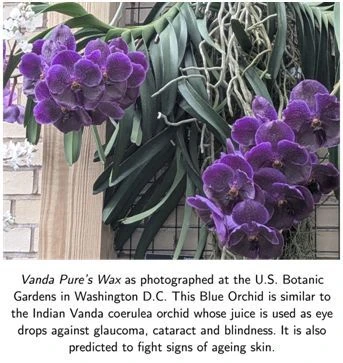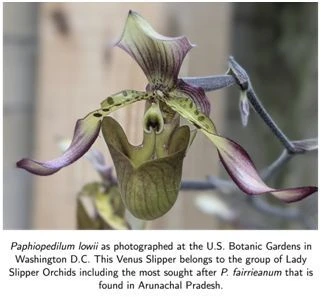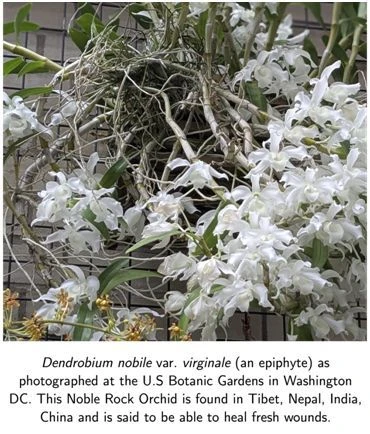
Preethi Rajasekaran
Sessa Orchid Sanctuary, nestled in Arunachal Pradesh, is one of the country’s best-kept botanical secrets. Orchidologists have documented the sanctuary's rich diversity of orchids. One lesser-known aspect of these plants lies in their evolutionary adaptations and complex pollination strategies. Fossil records trace their origins back over 100 million years (before the dinosaurs), revealing how these orchids have evolved with unique features that allow them to thrive in challenging environments. Their flower anatomy, alluring scents, and clever deceptive tactics to attract pollinators are just a few of the fascinating traits that make these orchids extraordinary. Let’s dive into the research behind their remarkable survival strategies.

In terms of habit, orchids could be saprophytic, terrestrial, epiphytic, or lithophytic. They rely on mycorrhizae as symbionts to nourish the orchid seedlings and for nutrition throughout their life. In terms of habitat, orchids are found in a diverse variety of conditions.
Orchids have evolved such nuanced traits in flowers that the pollinator-host relationship tends to be one-on-one often. Orchids typically have 3 sepals and 3 petals. Many orchids have a lip on which the pollinator lands to feed on floral rewards, and this lip is aligned 180° out of plane from the other petals. This resupination gives pollinators a landing pad and is predicted to highlight the landing strips via sunlight and increase athe mount of aerial scents through vapourisation. Considering all this signalling towards pollinators promising them rewards abound, what do the orchids reward?

Orchids have been found to use deceptive pollination strategies (~9000 species) by deceiving the pollinator to believe that it is a species that provides nectar (Batesian mimicry). Some orchids reward with wax or pseudopollen. They also employ sexual deception by mimicking the appearance or odour of the opposite-sex member of the pollinator species and luring the pollinator to copulate with the flower and thereby aid in pollination. Orchids also rely on scent to ensure successful pollination. Internal circadian clocks and external environmental cues help them synchronise the timing of scent release from the petals with that of the pollinator activity. We see how orchids have evolved to ensure that the pollinators visit the flower. How do they ensure that the pollinators actually pollinate?
Remember John Hughes’ Home Alone movies with trap doors, slippery surfaces and unexpected surprises. The orchid flowers aim to create that experience for the pollinators. They might secrete sticky fluids made of fragrant esters from the viscidium in Bucket orchids. Or close a trapdoor once the insect enters the flower, as in Greenwood orchids. Or target its victim pollinators by catapulting the pollinia once the pollinator lands on its hinged labellum. Or lead the pollinators through tunnels and picking up pollinia on the way. These myriad of ways to capture the attention and efforts of unsuspecting pollinators have evolved through millions of years of evolution. Hence the role of orchidologists.

The Orchids Research and Development Centre (ORDC), affiliated with the Sessa sanctuary has about 10,000 species of orchids under cultivation. So, the next time you stop by at the Eaglenest or Pakke Sanctuaries, make sure to visit the floral wonderland and trekkers paradise nearby with the Bugun people. The peaks & valleys, gorges & rugged terrain at more than 10,000 feet high would keep you coming back for more. And you might just be the lucky adventurer who discovers the possibly extinct Arunachal Ground Orchid (Spathoglottis arunachalensis), which would flower in September - October and win the Rs. 10,000 reward.
TERM | DEFINITION |
|---|---|
Mycorrhizae | The symbiotic relationship between the orchid roots and the fungi. |
Saprophytic | Plants that feed off of dead and decaying matter rather than photosynthesising. |
Epiphytic | Plants that grow on other plants like tree trunks rather than on the earth and have aerial roots. Eg: Vanda spp. (most) |
Lithophytic | Plants that grow on rocks (rock faces and crevices often) rather than on the earth. Eg: Dendrobium spp. |
Resupination | The process by which flowers twist about 180 degrees as they open. |
Labellum | The lip petal which is originally the top petal, but often ends up in the bottom through resupination. Made of hypochile, mesochile and epichile |
Pollinia | Organised masses of pollen grains which are transported as a unit. These tend to be hard for the pollinators to consume. |
Viscidium | A sticky part of the flower’s ovary which holds the pollinia and is disc shaped. |
Column | A unified structure of the male and female reproductive parts of the flower. A projection Rostellum could be present to physically separate the male and female parts. |
References
1. Arunachal Forest Departments - https://arunachalforests.gov.in/wildlife_sessa_os.html; https://arunachaltourism.com/sessa/
2. Arunachal Ground Orchid - https://india.mongabay.com/2021/12/in-arunachals-sessa-orchid-sanctuary-communities-collaborate-with-forest-officials-to-conserve-orchids/
3. Scopece, G., Cozzolino, S., & Dafni, A. (2014). Darwin on the pollination of Orchis-what he taught us and what we can tell him today. Darwin’s Orchids: then and Now. The University of Chicago Press, Chicago, IL, 23-46.
4. Photos from the Orchid Exhibit - https://www.usbg.gov/visit/exhibits/orchids-masters-deception
5. For grammar Check - OpenAI. (2023). ChatGPT (Mar 24, 2025 version) [Large language model]. https://chat.openai.com/chat
Author
Preethi Rajasekaran is a computer scientist turned ecologist with a love for statistical exploration of large datasets and finding patterns amidst the chaos. She aims to channelise this research into behaviour-based conservation.



